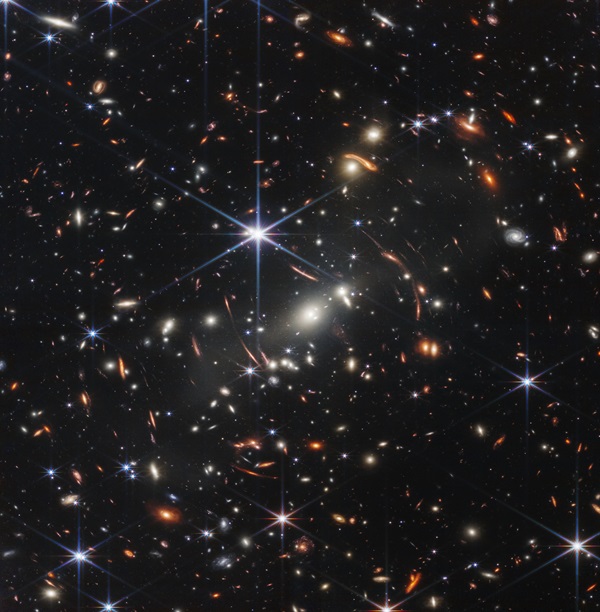Black Holes May Have Sped Up Star Formation After the Big Bang
Posted on Categories Discover Magazine

In the summer of 2022, when the James Webb Space Telescope relayed its first batch of images from the depths of space, it revealed something unexpected: The early universe was full of massive, bright galaxies — teeming with an astonishing numbers of stars — long before anything like them should have existed.
At that early stage of cosmic evolution, less than a billion years after the Big Bang, researchers argued, these stars simply shouldn’t have had time to get so big. As Jorryt Matthee, an astrophysicist with Institute of Science and Technology Austria, put it in a recent press release: “It’s like looking at a five-year-old child that is two meters tall. Something doesn’t add up.”
The discovery sent scientists in search of a way to explain these overgrown galaxies —which, at first glance, seem incompatible with what astronomers know about how the universe developed into its present state.
Black Holes: Cosmic Destroyers or Star Factories?
One possible answer comes from a 2024 study led by Joseph Silk, an astrophysicist at Johns Hopkins University and Sorbonne University. He noticed that their luminosity wasn’t the only striking thing about these galaxies — most of them also had a gigantic black hole at their center.
Silk doesn’t think that’s a coincidence. He believes those gluttonous behemoths, famed for their powers of annihilation, could actually be responsible for accelerating the birth of new stars. “[They’re] the missing catalyst that we appeal to to understand this phenomenon, which otherwise is totally bizarre,” he says. “We just connect two mysteries, and that gives us a solution.”
Though we imagine black holes irretrievably swallowing everything around them — they are, by definition, areas of such immense gravity that nothing can escape their grip — they actually spit out part of each meal, in what’s known as active galactic nuclei (or AGN) feedback.
Here’s how it works: As matter orbits a black hole, it forms an accretion disk akin to Saturn’s rings. That rapidly spinning disc heats up and, in a tremendous release of energy, shoots out jets of ionized particles and unimaginably hot gas. “The galaxy is caught in between,” Silk says. “It’s being crushed by these outflows.”
The process isn’t always as destructive as it sounds. He and his colleagues think these outflows were in fact “seeds for early galaxies,” reaching hundreds of light years out into their surroundings and whipping up amorphous gas clouds into stars. If they’re right, the presence of those bright galaxies isn’t strange at all; with black holes serving as amplifiers of star formation, they’re exactly what you’d expect to see.
Read More: What Happens in a Black Hole?
Which Came First, Black Holes or Galaxies?
If something seems amiss in this picture, it may be that it goes against the longstanding narrative of black hole formation, which is roughly as follows: When the energetic chaos of the Big Bang began to subside, fundamental particles stuck together as atoms, which combined into gas clouds, which became consolidated stars, some of which collapsed into black holes.
In other words, black holes are supposed to be the offspring of supermassive stars, not the other way around. Silk’s theory flips this story on its head, suggesting they came first. We’re dealing with a chicken-and-egg scenario of cosmic proportions.
It’s unclear how they would have formed if not by the traditional route. Some experts have hypothesized that enormous gas clouds may have collapsed directly into black holes, speeding through the (typically lengthy) star phase or bypassing it altogether. Others think they could be “primordial” black holes, hypothetical objects resulting from the collapse of dense regions of space in the first seconds after the universe was born. (These have also been proposed as a candidate for the elusive dark matter).
These would be tidy solutions to the JWST’s unforeseen observations, but for now they’re only guesses. It will likely take a new generation of interferometers — devices that can detect gravitational waves from the creation of black holes — to settle the matter. “That will finally put the bits of the jigsaw puzzle together and decide, Were the black holes there first, or were they formed more naturally by [known] astrophysical processes?” Silk says. “That’s the big question.”
Read More: How Do Black Holes Form?
The Universe Mellows Out
Whatever happened in that remote era, the time of rapid star formation is long gone. It seems to have lasted only from about 500 million years after the Big Bang to 2 or 3 billion years after. “That’s when all the fireworks are happening,” Silk says. “After that, things calm down.”
As the galaxies expanded, the distance across each one grew wider, and the raw material needed to make stars spread out until even those vigorous black hole outflows could no longer construct anything of it. Intense flashes of stellar productivity still appear now and then in nearby (that is, more recent) pockets of space, but by and large the cosmos have mellowed.
In the relative peace and quiet of the modern universe, we’re left to unravel what this influx of images from the JWST means for our understanding of how galaxies form. Scientists already knew that black holes were key drivers of galactic evolution, but Silk’s work suggests they’ve been even more influential than previously thought, and for much longer.
“Lot more to be done,” he says, “but the gaps are being filled.”
Read More: 7 of the Brightest Stars You Can See with the Naked Eye on Earth
Article Sources:
Our writers at Discovermagazine.com use peer-reviewed studies and high-quality sources for our articles, and our editors review them for accuracy and trustworthiness. Review the sources used below for this article: